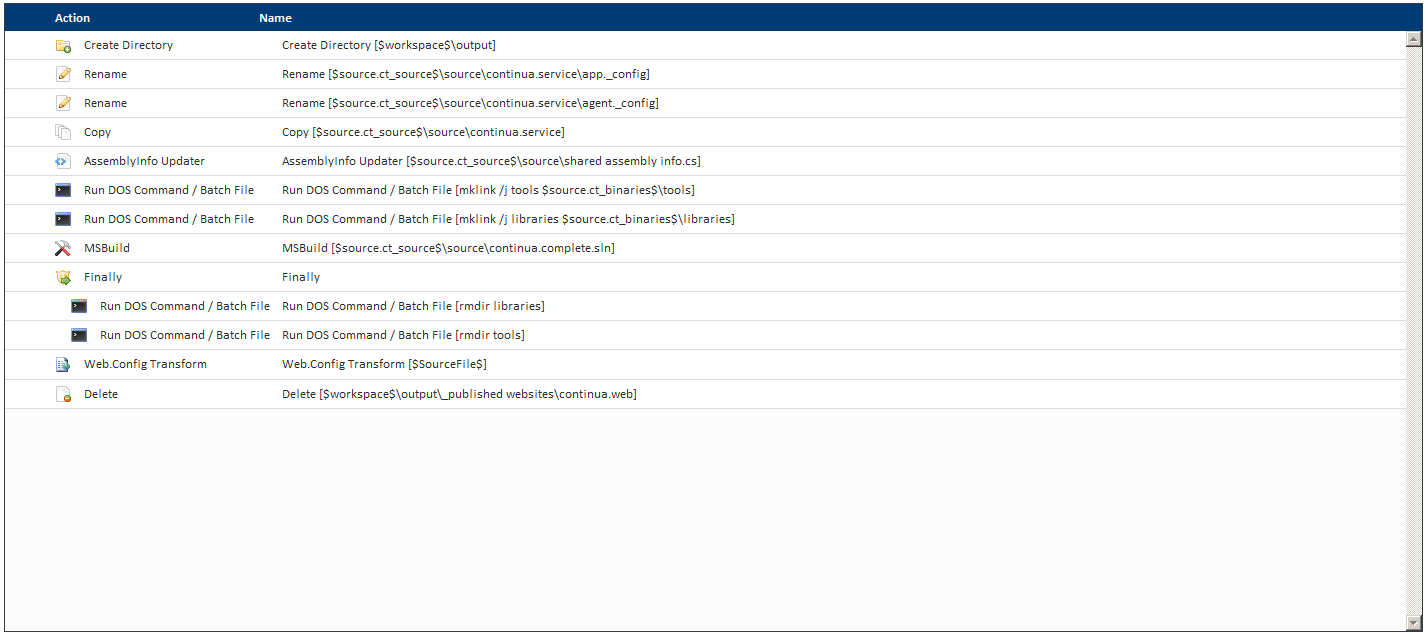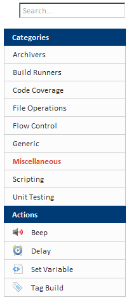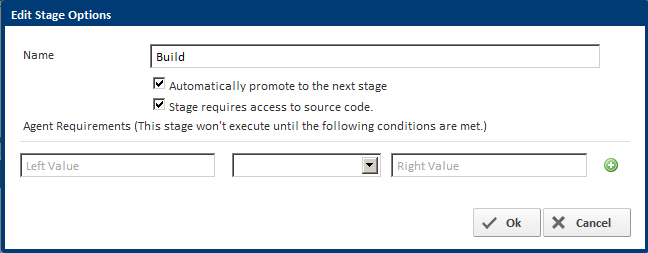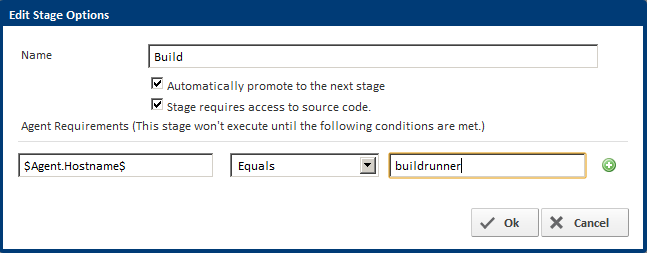Workflow Editor
The workflow editor is where you define actions for and control the flow of a build. The workflow editor is where you define a Configuration's Stages and also the actions to be performed in each Stage. The following image shows a newly created Configuration's workflow editor.
UI Elements
Stages and Stage Gates
Each Stage is shown as a gray chevron with the stage name in the middle of it. Single clicking on a Stage will display it's action in the Action Workflow below it. Double-Clicking on a Stage will display the "Edit Stage Option" dialog, stage options are explained below. You can also re-order stages by drag and dropping the stage before or after the other stages. The Stage Gate is displayed as a green chevron. Double-Clicking a Stage Gate will display the "Edit Stage Gate" dialog which is also explained below.
Stage and Action Toolbar
The Stage and Action tool bar provides shortcuts to modify stages and actions. The table below provides a short description of each option.
| Functionality | Result |
|---|---|
| Save All Stages | All changes made in the workflow editor will be saved. |
| Add Stage | Creates a new Stage. Pops up a dialog prompting the user to enter a stage name. |
| Delete Stage | Delete currently selected stage. |
| Edit Stage Options | Pops up a dialog and displays the currently selected stage's options. You can also see this screen by double-clicking the Stage. |
| Edit Stage Gate | Pops up a dialog and displays the currently selected stage's stage gate. You can also see this screen by double-clicking the Stage's Stage Gate. |
| Create Variable | Pops up a Create Variable dialog like the ones seen on the Variables wizard pages. Variables created through this dialog are Configuration Variables. |
| Move Up | Moves the currently selected action up the workflow. |
| Move Down | Moves the currently selected action down the workflow. |
| Move Left | Makes the currently selected action a child of the previous action. |
| Move Right | Makes the currently selected action a sibling of the previous action. |
| Edit Action | Pops up a dialog containing the currently selected action's options. You can also see this screen by double-clicking an action. |
| Delete Action | Prompts the user to delete the currently selected action. You can also deleted actions by selecting one then pressing the [Delete] button. |
Actions Workflow
The actions workflow is a list of actions in execution order from top to bottom. Actions can be moved around by using the arrow buttons on the tool bar and can be edited by double clicking them.
Action List
The action list allows you to search for actions by name and groups actions into categories for each navigation. When searching or click a category, the actions are displayed in the bottom pane under "Actions". Clicking an action will pop up a dialog and allow you to input properties for that action. The action will then be inserted as the last element in the action workflow. Alternatively, you can drag and drop an action from the action list to the exact position in the action workflow. Upon dropping the action, the same dialog pops up prompting you to input the action's properties.
Using the editor
Editing Stage Options
Stage Options are defined per stage and offer a number of ways to control the flow of the workflow. When a stage is executed on an agent, the agent will look for any repositories attached to the configuration and copy the contents of those repositories to its local machine. If your stage does not require access to anything in those repositories then there's no use copying those repositories so you would un-ticked the option "Stage requires access to source code". If you would like to stop a build at a certain stage so you can review the result before the next stage executes then you would un-tick the "Automatically promote to the next stage" option.
Note: If a stage is setup to not automatically promote to the next stage, you can later manually promote that stage from the builds page for that build.
Finally, you can choose to put Agent Requirements on the Stage which are checked before the stage is executed. By using conditions you can tell Continua to only executed that stage when all those conditions are met. For example, you can specify that the stage only run on an agent with a hostname of "buildrunner". The condition would look like this:
Editing Stage Gates
Stage Gates are attached to the previous stage and are simply a list of conditions that must be met before the next stage is executed. For example, you can creat a condition where it will only evaluate to true once the server's local time reaches midnight. Stage Gates also come with default conditions which specify that all unit tests that ran in the previous stage must have passed. You can however choose to remove these default conditions.






